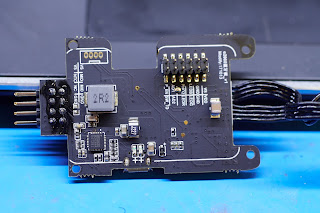The gimbal consists of a "main unit", which is attached to a handle by the means of a threaded collar. The handle contains the controls for the gimbal, as well as the batteries; it is not possible by default to turn the gimbal on without the handle.
The first task was to disassemble the handle. My hunch was that the handle suppled 7.4V (2S Li-Ion) to the inverters in the main unit, and sent pan and tilt commands via serial to a microcontroller in the main unit that ran the stabilization loop and talked to the inverters and IMU via I2C.
The Feiyu gimbals are remarkably easy to take apart - everything was held together with screws with not a plastic snap in sight. Removing the four Phillips screws from the top of the handle released the connector board:
The contacts for the spring-pins on the main unit are just pads on a matte black (!) PCB; the top board is just connectors with no active components.
Removing the four socket cap screws on the side of the handle reveals the bulk of the circuitry:
The backside isn't too exciting - a buck converter provides power for the electronics on the board (and possibly logic power for the inverters as well). The connectors are all neatly labeled, a nice touch.
Moving on to the inverters (we look inside one motor, but the other three are nearly identical):
The microprocessor is an STM32F303, an popular choice for gimbals. Two shunts are present - no cost-cutting one-shunt techniques were used here.
The power stage is an MPS6536 integrated brushless driver IC. The position sensor is not on the board; presumably, it is on the other side of the motor.
The connector board on the main unit reveals something surprising: unpopulated pads for a NRF51822 module are present.
Presumably at some point during development, a handle-less version was in fact planned, but was aborted before it reached full production.
Some further analysis:
The handle does have an microcontroller in it - it is possible but unlikely that the NRF51822 (which contains a Cortex-M0) is used for the stabilization loop. However, the only data lines running up into the main unit carry 115200 baud serial on them; standard async serial is not easily daisy-chained, and very few IMU's speak UART. Most likely, one of the inverter microcontrollers also does stabilization (this is the case on the Feiyu Tech wearable gimbals, which have no handle).










Hello,
ReplyDeleteI have an a2000 gimbal, I had an issue with it connecting to bluetooth or to pc so I can update the firmware, so I thought I would look around in there. So I saw that it has a nrf51822 chip in it. I thought why not flash the firmware directly to it., forgetting completely that it needs a bootloader and to pull the current firmware in case I brick it.
After searching online I found this blog! So I was hoping that (I realize that this is a long shot) but if you still have that gimbal around you can pull the firmware off the nrf51822 chip for me? In any case thank you for your blog!